
So local grain has slowly started to make its way back into the market and I chose to use a local Red Winter Wheat grown in Honeydew, Ca about an hour and a half from here. I splurged and bought 7 lbs to make a 60% Whole Wheat Sour w/ Cracked Wheat.
I've opted to push the envelope with whole grain with this project and my setup requires retarding of formed loaves so I can get through the multiple bakes. I have just devised an alternate route in which if final retarding won't work I can shape and preheat my oven (takes 2 hours plus) so that its ready as the bread is. But I will retard loaves when they are about 75% proofed just to slow them enough to get through the bake. I will experiment with this maybe next week. Then instead I can bulk retard the whole dough if desired.
Back to this loaf. So I made two builds of wheat on a touch of my white starter. The first was more to change it to wheat and the second the levain. The first build was 12 hours and looked really happy and healthy when I fed it again. I expected a 5-6 rise but it was doubled in 2 hours. Since I couldn't mix for a few hours I retarded it at this stage. I autolysed the final dough flour for 6 hours. I soaked the cracked wheat with hot water 6 hours as well. The first loaves I baked I pulled from retarder an hour before baking. Not liking the spring or results so much i followed baking straight from the retarder with much better results I'm not sure where to place the blame on the spotting of color. I think I coulda have shortened the bulk ferment and I probably should have added some malt.
Finally on my steaming progress. I went to the beach and collected a bunch of rocks instead of paying for lava rocks. This works nicely and you can hear the steam continue for longer. I need another beach run for more and I think I'll have a good thing going.
Build 1 (12 hours) Makes 1 - 1 kg loaf
30 g freshly milled red winter wheat (actually a few weeks old)
27 g H20
3 g white starter (100%)
---------------------------------
Build 2 (2 hours for me and then retarded until needed but watch yours)
49 Wheat Starter (90% hydration)
98 Fresh milled red winter wheat
85.75 H20
-------------------------------------
Soaker: Soaked for 6 hours
50 cracked Wheat
37.5 Hot H20
--------------------------
Dough
167 Fresh Milled Hard Red Winter Wheat
200 Bread Flour (11.5 % protein)
323.3 H20 (hold out 10 percent)
11 Salt
----------------------------
Autolyse Dough at least 30 minutes before finish mix.
(I went for 5 1/2 hrs)
Add levain and mix on speed 1 to incorporate. (5 mijnutes)
Add salt and continue mixing on speed 1 for until mixed in.
Mix on speed 2 (low medium on my 4 speed machine)
Mix until medium development. Add grain soaker and additional h20 and mix in on speed 1( This took about 5 minutes). Finish on speed 2 for a minute.
Bulk Ferment 4 hours with 5 S+F at 30 minutes.
*this is what I did and I think I would shorten the bulk ferment by at least 30 minutes if not an hour. Also I'd do the s + f's at 15-20 minute intervals.
Shape, proof at room temp for 1 hour and retard for 8 hours. Bake cold with steam.
Pictures to come after market
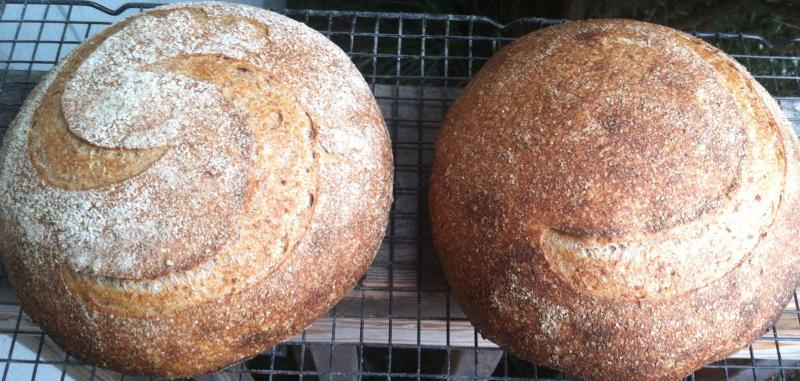
First loaves here. The ones I pulled from retarder for an hour pre bake. Not great spring very little blooming and no grigne.

Now for the remainder I baked straight from retarder and got great spring. Good Bloom and some serious grigne
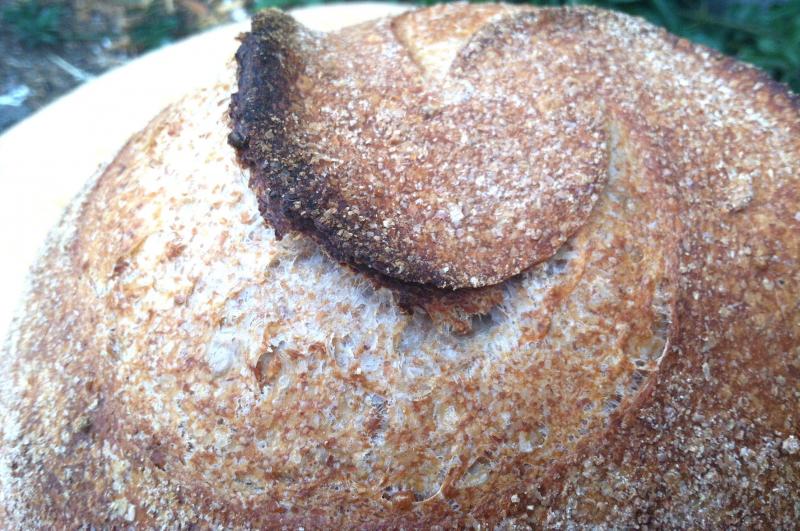


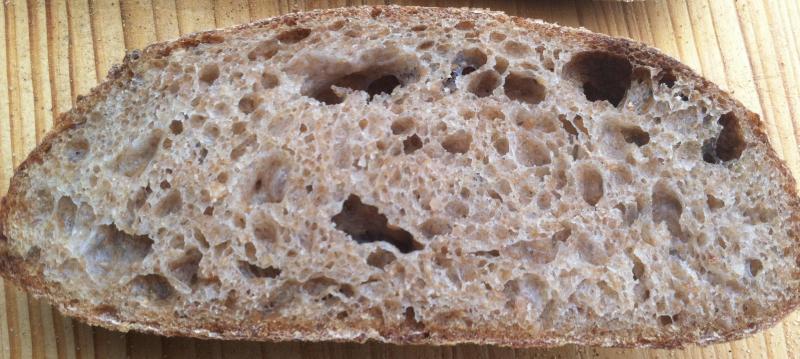
This is the crumb from the first set that didn't pop as much. I sliced a nicer loaf later and forgot to take a picture but it was even better.

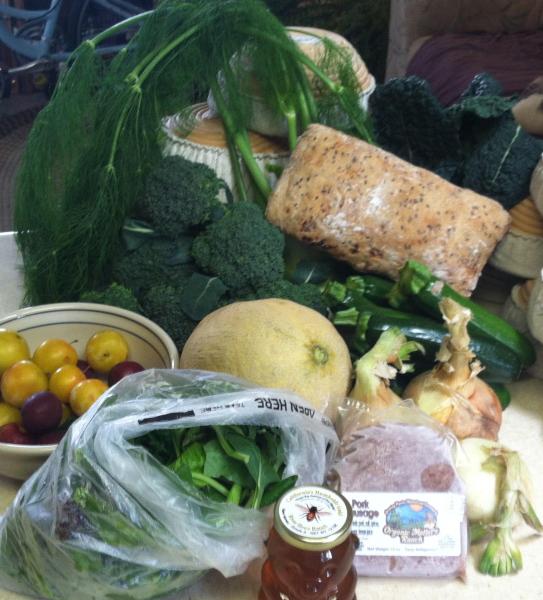
So we got some plums (2 types), local honey, salad mix, breakfast sausage, walla walla onions, brocolli, fennel, kale, zukes, fresh cantelope, and a loaf of 25% wholegrain flax seed cranberry ciabatta.
Happy Baking
Josh
- Anonymous's Blog
- Log in or register to post comments
baking right out of the fridge is the wayb to go. That crust and crumb are first rate for so much whole grain. I think you need to ask for more for your bread at the market?
Happy baking
Those are some beauties. Love the idea of using beach rocks for your steaming effect.
As always thanks for the comments. Oh I think I get plenty at the market for my efforts. Its more of a collective sharing of goods than it is a profit making scheme although I seem to do well. Taboot I just tell them a rough value of a loaf $5 retail and what items I'm interested in and to give me what they think is fair. I end up with food for the week. Its working. One of these days I'll show up with pound cakes and thats when I'll ask for more.
Josh
Lovely scoring patterns and nice blistering. Blistering, for me, is one of the most attractive features of a loaf. It is what would entice me to buy it. I know the French see it as a fault (or so I have heard) but I always think of it as a harbinger of great flavor and it just looks so attractive, too.
Nice baking and great trades!
Syd
Very nice loaves there Josh! Crust, crumb and all. I love adding cracked wheat in my loaves whenever I can. Such a satisfying ingredient.
Great job, thanks for sharing this one.
John
Both of you. I agree Syd. I like the blisters. So I won't win the Coupe De Monde or whatever its called. Not a problem. I want a blistery dark crust with deep red tones and a bit of a sheen to the eye but when you touch it, it feels like sandpaper. If its smooth its over steamed and gets too leathery.
What next? Probably gonna try and use the local white wheat that everyone says isn't strong enough to raise a loaf and then go ahead and make a loaf with it. Maybe 100% white wheat baguettes.
Josh
Absolutely GORGEOUS !!
anna
> what grain mill do you use? (I'm assuming you're milling your own WW)
> what's the initial oven temperature? is the temperature reduced at any time during the bake?
=========PS=========
I've been following your blog and am fascinated by your barter approach with other vendors at the farmer's market. All your loaves are terrific though I really like this formula. Intend to try it.
Took the time to work out the baker's percentage for this bread. Seems like a very high hydration dough (that's assuming I did my math right). Is that because of all the whole wheat?
thanks - SF
Thanks Anna.
SF. My work does have a mill and I generally mill my own wheat and rye. this flour was local and milled by another bakery. It's milled a bit finer than I grind but beautiful stuff. I forget the variety. I just missed out on the Red Fife. Pretty sure its about 5 or 6 varieties of heirloom wheat (red winter and white what) being grown. Also some barley specifically for beer but I intend to check that out too. Anyway. Yes lately I formulate my hydration by targetting each flour individually and then taking the sum. In this case I believe I set the wheat at 100% and the white at 70 which resulted in 88% hydration plus the soaker (which soaked up all its water and was fairly dry but softened).
As for baking temps. Well I have a really basic (yet fairly new) home oven. I've added two super heavy 20x15 slabs of soapstone. I use one brownie pan with 6 rolled towels for steam along with a cast iron with rocks in it hit with ice water. I preheat my oven for about 5 hours starting late at night. This loaf I started at 500 and lowered to 470 after 5 minutes. Removed steam after 13 minutes. Continued baking for about 20 minutes.
Happy you enjoy and post pictures of your results. The last guy "song of the baker" actually made a nicer loaf of my 40% rye. Which is fantastic. Anyway happy baking.
Josh
Josh, why the 5 hour pre-heat? Do you feel that really helps? I only preheat my oven for about 1 hour and it seems to work well.
Ian
and I've found no less than 3 hours or they lose some heat during my 4-5 waves of loaves on it. That five hours is me being lazy and starting it as I go to bed for 4 hours then wake up and prepare. Once the oven gets up to 500 it takes minimal work for it to stay hot. Plus my stones are ripping when i bake and I've gotten great spring and nice bottom crusts.
Josh
Those loaves look gorgeous, Josh! lovely scoring on all of them, with a fabulous crust. The crumb shows excellent fermentation too.
-Khalid
Thanks Khalid
I still want to try your 60% Rye with that beautiful open crumb I saw some time back. Do you still have that formula?
Josh
I put together the baker's percentage for myself but thought others might be interested. I'm using the formula standards promoted by the Bread Bakers Guild of America (originally posted to TFL by proth5). The first table is simply an overview of the loaf. The next table is a continuation of the first and has the details for the bread's components (sourdough levain, soaker and final dough). There is a two-stage build for the levain and the BBGA article gave no hint as to how to present this, so I did two more tables, an overview and a detail one. [h4]60% WHOLE WHEAT SOURDOUGH WITH CRACKED WHEAT[/h4][h6]Table 1A: Overview[/h6]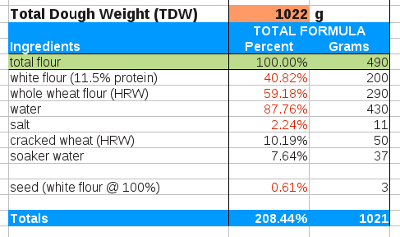 [hr] [h6] Table 1B: Formula Details[/h6]
[hr] [h6] Table 1B: Formula Details[/h6] [hr] [h6]Table 2A: Levain Overview[/h6](This table is simply a recap of the first two columns of Table 1B)
[hr] [h6]Table 2A: Levain Overview[/h6](This table is simply a recap of the first two columns of Table 1B) 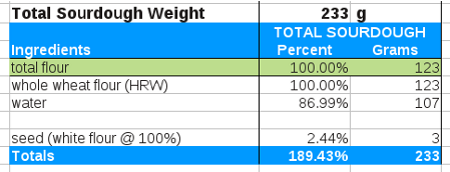 [hr] [h6]Table 2B: Levain Build Details[/h6]
[hr] [h6]Table 2B: Levain Build Details[/h6]
Is this a program you use or do you write these using spreadsheets? I am untrained via spreadsheets but would love a serious professional program that is already set up for bread formulas. There must be such a thing
Josh
...not a program. I'm just a home baker so I don't know if there is a "serious professional program that is already set up for bread formulas". Sorry that I can't help with that.
The only constants in the spreadsheet are the total (prebaking) dough weight, the percentages for the total dough formula (Table 1A) and the percentages for the levain (Table 2A). All other cell entries are formulas and the actual values flow from these constants.
To construct the spreadsheet, I started with your weight amounts (plus the total dough weight, which you also gave) and used a spreadsheet to calculate the percentages from these amounts. I then took the percentages (which were formulas) and *converted them to constants* and recalculated actual weight amounts based on these constants as a double check for accuracy. This is Table 1A.
I also had to calculate the sourdough builds, which was a bit more complex. You did levain build #1 with 3 grams established white flour sourdough starter plus 39 grams WW flour and 27 grams water (90% hydration) for a total of 60 grams refreshed levain from which (when risen) you took 49 grams and refreshed it with an additonal 98 grams whole wheat flour and 86 grams water. I did my best to [i]approximate[/i] this scenario. My [i]assumption[/i] was that you wanted an initial small levain build (levain build #1) in order to ensure that your 100% hydration white flour starter would succeed with a change to a feeding of whole wheat flour. [i]If[/i] this was successful (as it was) you then proceeded in levain build #2 to feed it additional whole wheat flour and water to bring it up to the required levain amount and desired overall hydration for the starter. The basic table for the levain is Table 2A and Table 2B is [i]my approximation of your two-stage build procedure[/i].
I think standards are good which is why I used the BBGA standard, though, as I noted, I had to wing it for your two-stage levain build. My personal spreadsheet layout is somewhat different from the BBGA standard. However, the ideal of any approach is that, once the spreadsheet is set up, it allows the baker to change the value for the prebaking dough weight (x loaves @ y grams per loaf) and the spreadsheet automatically updates all weight quantities based on this one simple value.
I really should take a serious look at setting up a spreadsheet template for a particular bread formula (for example, yours) using Google docs. It would be nice if TFL readers could just plug in how much dough they want to produce for a baking and have all the quantities calculated for them. A project for the future. :)
Hope this helps - best - SF
@subfuscpersona
"readers could just plug in how much dough they want to produce for a baking and have all the quantities calculated for them."
I've been using a format I put together a few years ago that's does exactly that. It was done similar to the formula layout that Hamelman uses in "Bread", and created using OpenOffice. It's more of a calculator or scaler compared to the BBGA format but I find it easier to read and it gives you all the basic info in the Overall Formula summation at the bottom. Don't know if this is what you had in mind but have a look and maybe it will give you a starting point for your own template. The green shaded percentage cells can be edited for tweaking the formula. Hope this helps. Link to sheet *HERE*
Franko
So cooooooool. Very informative. Sent you a PM elaborating my thoughts (don't want to highjack this thread with programming issues re spreadsheets). Best - SF
Replied to your PM just now.